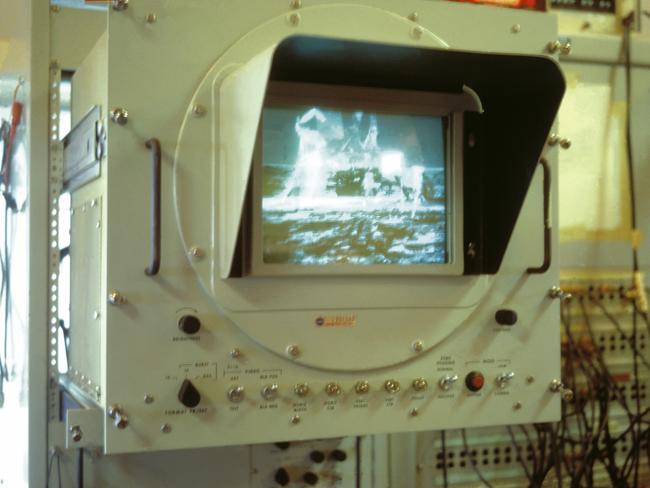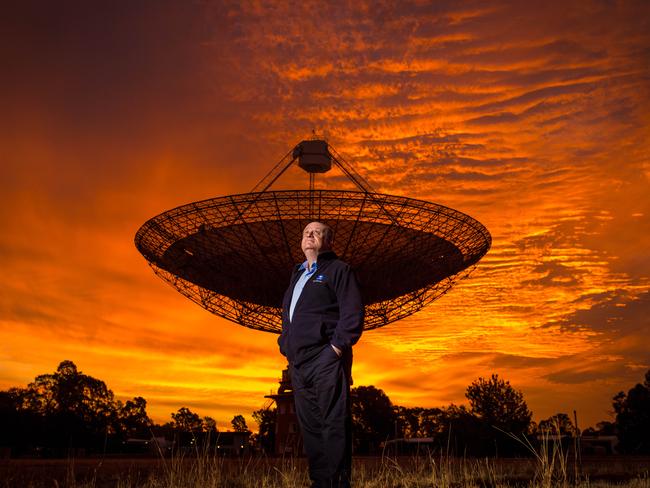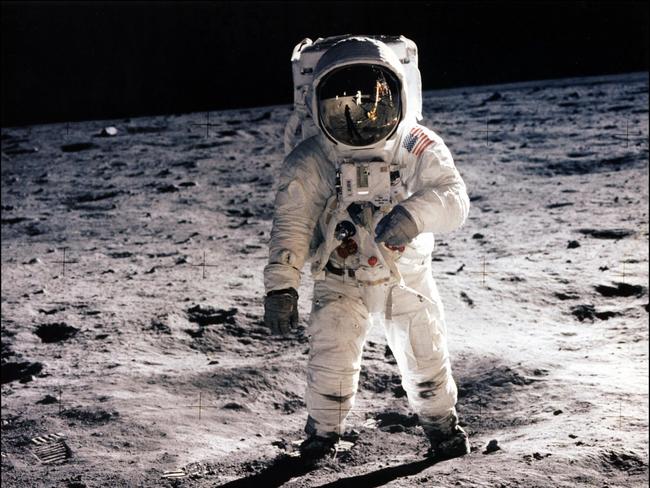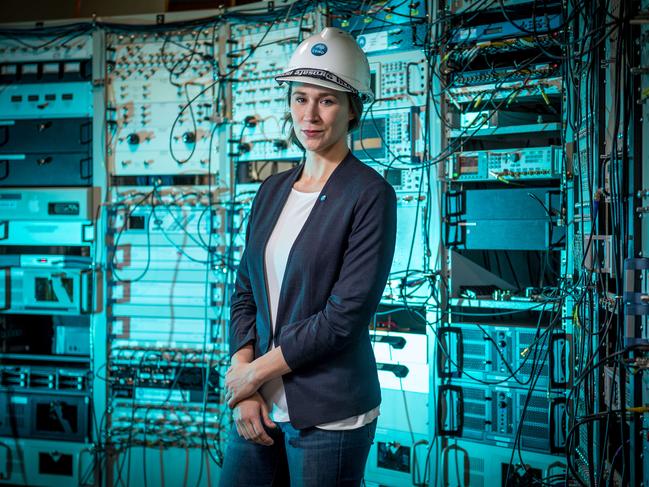Moon landing 50th anniversary: The incredible story behind The Dish at Parkes
When Neil Armstrong took his first steps on the Moon 50 years ago, Australia beamed the historic moment to the world — and even those inside The Dish at Parkes were amazed to see the grainy images. Here’s why.
VIC News
Don't miss out on the headlines from VIC News. Followed categories will be added to My News.
​​A team of bespectacled blokes with neat thinning hair, ties and knitted cardigans were the first to witness mankind’s greatest achievement.
Vision of Neil Armstrong stepping foot on to the Moon crackled to life on a small monitor, tucked between an array of analogue switches and dials.
The staff at CSIRO’s Parkes radio observatory couldn’t quite believe it.
For months before that historic moment almost 50 years ago, director John Bolton had worked tirelessly to ensure The Dish would be ready to transmit the first signals from the lunar surface.
Yet in the final few hours before the scheduled touch-down he feared his meticulous plan might be scuppered.
A storm front with wind gusts of up to 110km/h threatened to rip the observatory from its hinges.
Never before had The Dish been exposed to such extremes.
Electrician Ben Lam, now 82, recalls the anxious moments as the weather conditions worsened.
“We couldn’t trust the power supply, so we had to run our own diesel because we just didn’t know what was going to happen,” he said.
Then a schedule change meant the astronauts planned to exit the lunar module before the Moon had risen above the horizon to give the observatory a clear transmission.

But when Armstrong finally issued those famous words just after 1pm on July 21 AEST (July 20 in the US), everything was in place.
Nervous smiles stretched across their faces as the grainy footage was transmitted.
“That’s one small step for man …” Armstrong said. “One giant leap for mankind.”
HOW AUSTRALIA BECAME PART OF THE MOON LANDING
More than 600 million people around the world watched the Moon landing, thanks to Australian technology and technicians.
The local receivers were recruited by NASA the year before when the Americans realised they needed 24-hour contact with their lunar recruits.
In the end, the faint signal emitted by the lunar lander was captured by radio telescope receivers at Honeysuckle Creek, near Canberra and the facility at Parkes.
For years, management at the two sites argued over which team was responsible for transmitting the famous footage first.
It wasn’t until 1993 that directors for both observatories put an agreement in writing.
The first Apollo 11 television image of man stepping foot on the Moon, was in fact, transmitted from Honeysuckle Creek.
But the majority — and the best-quality images — came from Parkes.
David Cooke, 87, was a receiver engineer and among the staff crowded round the monitor that day.
Even now, he says it’s hard to articulate what it was like to have played his role in history.
“I saw the picture of Armstrong coming down the ladder and putting his feet on the Moon on that little green TV screen,” Mr Cooke said.
“After it was all over I went outside and the Moon was still there above us, of course.
“I was quite amazed to think, well, there were men up there and we had been a part of helping them get there.”

Arching his head skyward, Mr Cooke ensured it would be a moment cherished.
He took a photograph of the dish tracking the Moon with the passing storm in the background.
Little did he know, 380,000 kilometres above him, one of the astronauts would snap an image of his own — an aerial view looking back toward New South Wales, with the storm that had proved so problematic, swirling over eastern Australia.
Supplying vital footage of the Moon landing had been a cumulative achievement for the Parkes staff, who had each been told they were likely guaranteed work for another decade.
But more than half a century later, few could have realised the role the telescope would play in space research, nor the cultural significance it would earn in the hearts and minds of Aussies everywhere.

AUSTRALIA STILL AT THE FOREFRONT OF RADIO ASTRONOMY
Tourist numbers to The Dish increased steadily following the release of the Australian movie of the same name.
But it’s the continued work of the observatory and the professionals within it that is ensuring it remains at the forefront of telescopic radio exploration.
Parkes was equipped with a multi-beam receiving system in 1997 enabling it to detect radio signals emitted by neutral hydrogen gas, which in turn, gives information about how much matter there is in the universe and how it is distributed.
Operations scientist John Sarkissian first started at the CSIRO Parkes Observatory as part of the team monitoring the Galileo mission to Jupiter in 1996.
It was a dream gig — tracking the spacecraft as it paced itself around the planet and its Moons.
“I was one of three operators to do the daily tracking work and I loved it,” Mr Sarkissian said.
“In many ways it was a dream come true.”
HOW YOU CAN RELIVE THE MOON LANDING AT PARKES
AUSTRALIA SET TO GET A MISSION CONTROL CENTRE
THE VICTORIAN COUPLE WHO WANT TO LIVE ON MARS

More than 20 years later, the scientist is among a contemporary team leading the advancement of radio astronomy in Australia.
While the Parkes observatory appears to be a clunky mix of 1960s analog and new-era digital, Mr Sarkissian said it remained one of the best telescopes of its kind in the world.
“We are still doing world class science,” he said. “Making great discoveries that are revolutionising and reshaping our understanding of the universe.”
Synonymous for its role tracking the Apollo missions, The Dish has continued to collaborate with NASA.
More recently, it tracked Voyager 2 as it crossed into interstellar space.
“That was something fantastic,” Mr Sarkissian said. “Forty-two years ago when I was looking at that image on my mathematics text book, Voyager 2 was launched.
“We have tracked that spacecraft several times over those years.”

Meanwhile, a smaller telescope at Parkes has been used to observe the Vela pulsar — the compact remains of a massive star believed to have exploded 11,000 years ago.
The material from the explosion has created the Vela supernova remnant — an expanding shell of gas a hundred light years across.
At its centre is the remains of the exploded star, a pulsar. It is only 10km in diameter with the mass of one and a half suns.
“A thimble full of material would weigh hundreds of millions of tonnes,” Mr Sarkissian said.
He said Parkes was responsible for discovering more pulsars than any other telescope in the world. It’s a major area of research at the Observatory.
Its most recent major discoveries includes a series of fast radio bursts — sudden bursts of radio energy that originate billions of light years from earth and last only milliseconds.
Where these bursts come from remains a mystery.
Some speculate they could be anything from the result of the collision of black holes to an extraterrestrial beacon.
“We keep an open mind on all these things,” Mr Sarkissian said.

Astrophysicist Dr Jane Kaczmarek said Parkes’ role in space research remained as relevant as ever.
“One of the very unique things about Parkes is that it has been so flexible,” she said.
“It has been able to meet the challenges of new technology but also improve on them.”
She said in many ways, The Dish was driving the new technology.
“The kind of science that Parkes does is relatively young when you think about how old astronomy is,” Dr Kaczmarek said.

“The future of radio astronomy in Australia is incredibly bright because we have telescopes like Parkes that have always been here but we are building others like the Australian Square Kilometre Array Pathfinder in WA that will be powering the next generation of surveys and science.
“No other country in the world can do this kind of radio astronomy because Australia has a lot of open space and radio astronomy is able to capitalise on that.
“I would even argue that Australia is one of the main contenders driving the entire field, driving our understanding of how we got here, who we are and how it all came to be.”
So how do space scientist reconcile the vastness of space with human existence?
Both these Parkes scientists say they’ve found greater meaning gazing skyward.
“I like to think I find calm knowing how big it all is and how small I am,” Dr Kaczmarek said.
“That actually gives me a feeling of grace — that humans are getting to the point now where we are able to answer some of the questions around how we arrived here.
“The Parkes telescope is constantly evolving as it tries to answer that question.
Mr Sarkissian agreed.
“As far as we know, humans are the most complex beings in the entire universe,” he said.
“Sure, we may be very small in comparison to this vast universe but it doesn’t make me feel insignificant.
“I think it gives you a greater appreciation of who we are.”
Pick up a copy of our Moon landing 50th anniversary souvenir magazine, One Giant Leap, for $4.95 from newsagents in Victoria, New South Wales and South Australia from July 6.


